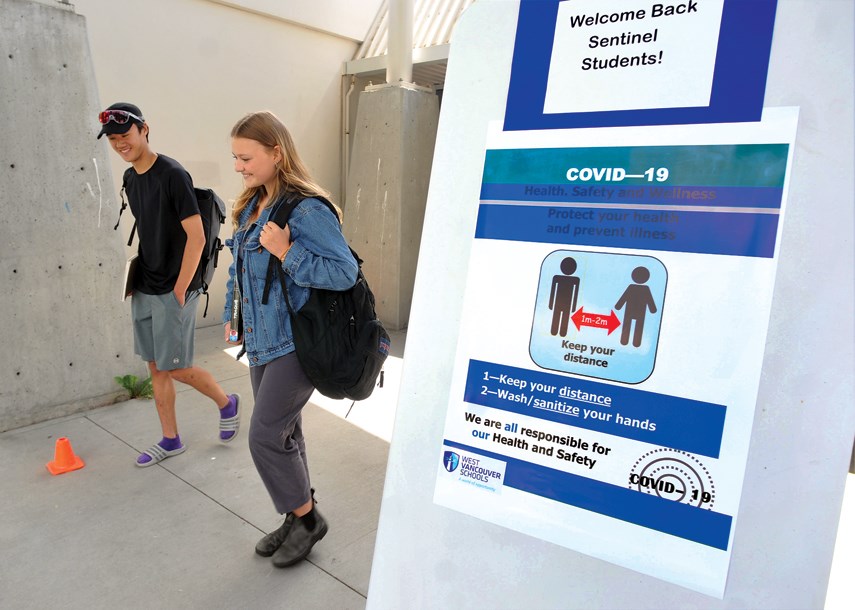Most of the North Shore’s approximately 22,000 students will be heading back to the classroom in September under a return-to-school plan announced by Education Minister Rob Fleming on Wednesday.
The Ministry of Education’s plan will see “most students returning the classroom fulltime,” Fleming said at a press conference Wednesday.
Provincial health officer Dr. Bonnie Henry acknowledged the return to school won’t be without risk, but said that needs to be balanced against the adverse impacts of being out of school on many children and families.
“For students, being in class is about learning, about being in class, about seeing friends,” she said. Henry said that having children in school is also essential for many parents “to be able to work and to be able to cope with this pandemic.”
“I know for many students and staff being in class is where they want to be and where they need to be.”
Under the plan announced Wednesday, most elementary school students will be in class full-time with a regular classroom teacher in September.
In addition, students will be divided into “cohorts” of about 60 children who they will have recess and lunch times with and be able to play outside with. The idea is to limit the number of children who regularly interact with each other so that chains of transmission can more easily be isolated and tracked if there was a case of COVID-19 in a school.
Bigger changes are afoot at the secondary school level, where students will be divided into cohort groups of 120 students, who interact mainly with each other.
To accomplish that, it’s likely that school timetables will have to go through some significant revision from the current models.
“It really shifts how we think about high schools,” said Chris Kennedy, superintendent of the West Vancouver School District.
The usual system where students take eight classes in rotating blocks “doesn’t seem feasible under this system,” said Kennedy.
Instead, teachers and school planners will have to think of a 1,200-student school more like “10 little schools of 120 students each,” he said. That could mean students taking two to four courses for a much shorter period of time before “resetting” the cohort to take different classes, said Kennedy.
Under the plan announced Wednesday, most students will not take part in a “hybrid” model, combining online and in class learning.
Possible exceptions are large high schools with over 1,500 students, which “in rare cases, may need to offer a hybrid approach with a blend of remote online and self-directed learning,” according to the ministry.
According to the ministry of education, enrolment at Handsworth Secondary in North Vancouver is hovering right around that number.
School districts are expected to inform parents of their plans no later than Aug. 26.
Andrea Sinclair, president of the BC Confederation of Parent Advisory Councils, said according to a survey of parents conducted by the ministry of education, most parents want to see their kids return to the classroom. “Overall the majority of B.C. parents found it incredibly difficult to support their children academically, while working from home full time,” she said.
Reaction from teachers to Wednesday’s announcement was lukewarm, with B.C. Teachers Federation president Teri Mooring saying teachers need more time in September to plan for a full return to the classroom.
Renee Willock, president of the West Vancouver Teachers Association, said she was surprised by the announcement of a full return to school for high school students.
“Older students spread the virus the same as adults do,” she said. “High schools are big busy places.”
While about 95 per cent of West Vancouver teachers returned to the classroom in June, Willock said that was when there were only up to half of the usual number of students in class – and often far fewer.
“A lot of teachers are feeling more nervous than they were in June,” she said.
Teachers who are simply uncomfortable with returning to the classroom or who may be in older age groups are not expected to get an exception to classroom teaching, she said.
Willock said one positive note is teachers aren’t being asked to both teach remotely and in the classroom at the same time, the way they were in June. “We’re not trying to do two things at once,” she said.
Families who don't feel comfortable sending their kids back to the classroom have the option of signing up for distance learning programs.
Nobody from the North Vancouver School District was available to comment on the ministry’s return-to-school plans this week.
Both Henry and Fleming said public health officials will be monitoring school re-openings in the fall and will be prepared to step in and make changes if they see cases of COVID-19 transmission ticking up.
“There’s no magic number,” said Henry.
Fleming said lessons learned in the partial re-opening of schools in June – when approximately 200,000 students went back to school part-time - have been part of the planning process for September.
Among the measures announced Wednesday by the ministry was an additional $23 million in funding for extra staff time to clean schools, $5.1 million for cleaning supplies and $9.2 million for more hand-washing stations.
Masks will not be mandatory in schools but will be made available for students and staff who want them. Older students will also be encouraged to wear masks in situations where they can’t maintain a safe distance with those outside of their learning groups, such as riding the bus to school.



